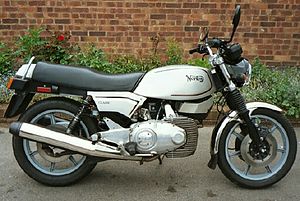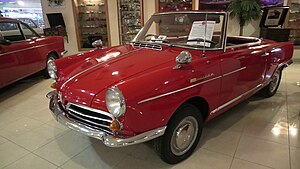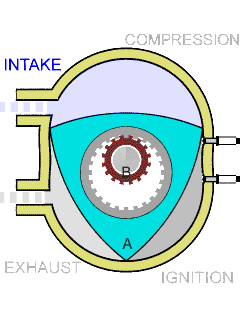David Garside
David W. Garside is an inventor[1] and former project engineer at BSA's Kitts Green research facility. He is notable for having developed an air-cooled twin-rotor Wankel motorcycle engine which powered the Norton Classic road bike.[2][3] Although the Classic was not the first production rotary-engined bike, it was significantly lighter, smoother, more powerful and better-handling than the contemporary Suzuki RE5.[4]
Personal history
In his book "Norton Rotaries", Kris Perkins states that "David Garside could rightly be called the father of the Norton Rotary". Garside studied mathematics and mechanical engineering at Emmanuel College, Cambridge, where he obtained a first class degree. He served an apprenticeship with Rolls Royce, and after a spell at the CEGB, he returned to Rolls Royce to work on diesel rotaries. He later moved to BSA as a development engineer at Kitts Green. After BSA was subsumed into NVT, over 90% of BSA's research projects were cancelled, but Garside managed to persuade NVT's boss, Dennis Poore to continue with the rotary programme. The project moved to Shenstone, near Lichfield, where production of bikes such as the Interpol took place.[5]
The Norton Classic


Garside, who had been impressed by the Fichtel & Sachs engine in both the NSU Spider sports-car and a snowmobile, installed a bought-in F&S air-cooled single-rotor engine into a BSA B25 'Starfire' frame as a "proof of concept". This proved reliable and smooth, but under-powered. Garside then created a prototype twin-rotor engine (with F&S rotors), which doubled the capacity of the earlier test "mule". This twin-rotor engine was installed in a BSA A65 frame.[6] (In Europe, DKW later used a fan-cooled single-rotor F&S engine in the DKW Hercules motorcycle, but this was less radical and much less powerful than the Norton Classic).
Wankel engines run very hot,[7] so Garside gave this air-cooled motor additional interior air-cooling. Filtered air was drawn through an intake that was forward-facing to provide a ram air effect. This air was channelled initially to the rotating mainshaft and through the interior of the two rotors, then entering a large pressed-steel plenum before entering the combustion chambers via twin carburettors.[8] The plenum, which doubled as the bike's semi-monocoque frame, enabled the transfer of much of the heat to the surrounding atmosphere. (This idea was taken from the monocoque Ariel Arrow).[9] The carburation process further reduced temperatures via the heat of evaporation.
Even so, at 50 °C (122 °F) the fuel-air mixture was still hotter than ideal, and the engine's volumetric efficiency remained somewhat impaired. The eccentric shaft's main bearings and the inlet manifolds were fed by oil-injection lubrication, and the fuel-air mix also carried residual mist of oil from the interior of the rotors, which helped to lubricate the rotor tips.[10]

Notable innovations

The Wankel KKM cycle:
- A: Apex of the rotor.
- B: The eccentric shaft.
- The white portion is the lobe of the eccentric shaft.
- The distance between A and B remains constant.
- Produces three power pulses each revolution of the rotor.
- Gives one power pulse per revolution of the output shaft.
To address the deficiencies of the air-cooled Norton Wankel engine, Garside went on to develop SPARCS (self-pressurising-air rotor cooling system),[11] a system that utilises self-pressurising blow-by gases as a cooling medium, absorbing higher levels of heat from the engine core and dispersing the heat by means of an external heat exchanger. This system provides superior heat rejection than standard air cooling methods.[12]
In addition to SPARCS, Garside also filed a patent in 2011 to develop a rotary exhaust expander unit or CREEV (compound rotary engine for electric vehicles) for use with Wankel rotary engines.[13] The CREEV system acts as an ‘exhaust reactor’ by consuming unburned exhaust products while expansion occurs, reducing overall emissions and improving thermal efficiency.[14]
In 2015, David Garside signed a licensing agreement with UK Midlands based engineers Advanced Innovative Engineering (UK) Ltd for exclusive use of his patents in their next generation Wankel rotary engines.[15]
Aero-engine derivative
The Norton Wankel engine was further developed at Staverton airport into the MidWest aero-engine. The MidWest engine's output increased from BSA's 85 bhp to nearly 110 bhp[16] by improving volumetric efficiency. This was achieved by feeding pressurised air to cool the rotors which was then dumped overboard (rather than fed to the combustion chambers); the engine received a fuel-air mixture with cool ambient air.[17]
References
- ^ Garside's patents
- ^ The Wankel Rotary Engine: A History By John B. Hege page 137, ISBN 978-0-7864-2905-9
- ^ Denniss, Tony (1990). "The Norton Rotary". Retrieved 14 August 2011.
- ^ Perkins, Kris (1991). Norton Rotaries (pp 30, 36). The Crowood Press. ISBN 978-1-85532-181-6.
- ^ Perkins, Kris (1991). Norton Rotaries (page 42). The Crowood Press. ISBN 978-1-85532-181-6.
- ^ "Bike" magazine Summer 1973
- ^ Note: unlike a reciprocating engine, where the combustion chamber is cooled by the incoming fuel-air charge, a Wankel engine's combustion zone is never cooled in this way and so always stay very hot.
- ^ "Cycle World" magazine February 1971
- ^ Bill Murray monograph 1985: "The decline of the British motorcycle industry"
- ^ Bill Murray monograph 1985: "The decline of the British motorcycle industry"
- ^ "World Intellectual Property Organization Pub. No: WO2009101385". World Intellectual Property Organization.
- ^ Ian, Bamsey (April 2016). "Cool Running". Unmanned Systems Technology Magazine (7).
- ^ "World Intellectual Property Organization Pub. No: WO/2009/115768". World Intellectual Property Organization.
- ^ "CREEV | Advanced Innovative Engineering (UK) Ltd". Retrieved 20 September 2016.
- ^ https://www.aieuk.com/aie-sign-exclusive-licence-agreement-use-patented-engine-technology/ [bare URL]
- ^ MidWest Engines Ltd AE1100R Rotary Engine Manual
- ^ The MidWest engines were both water-cooled (the rotor chambers having cooling jackets) and air-cooled, with a belt-driven centrifugal pump forcing pressurised cool air through the engine's interior.
